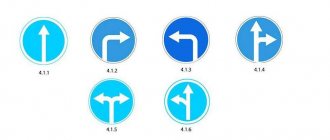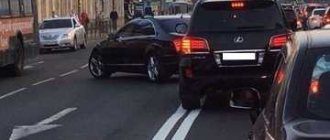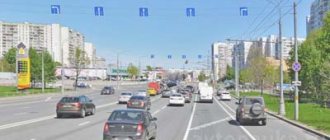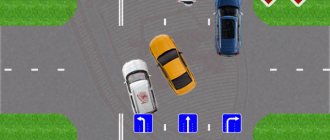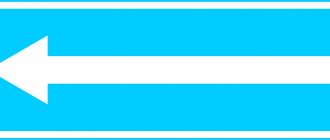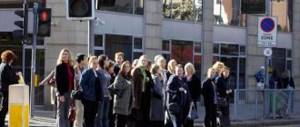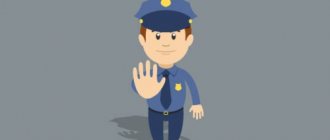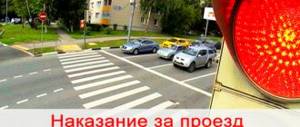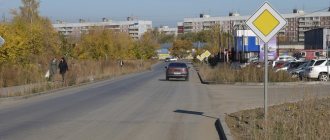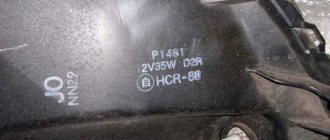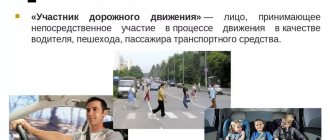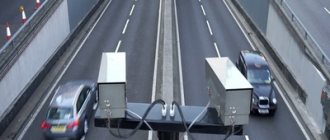Which trajectory is allowed to turn left?
Making a turn at an intersection can be divided into several stages (when turning left).
The very first thing you should pay attention to is preparation for the turn.
This is the first stage.
In order to correctly make a left turn at an intersection, you must first take the leftmost position on the side of the roadway in your direction. If the markings are visible, then this will not be difficult to do.
The next step is the actual rotation. One of the main conditions: choose such a trajectory of movement so as not to end up in the opposite direction. Next you need to get to the center at the intersection itself. This position is the most convenient for this maneuver, because it reduces the time for turning.
Left turn path
If you do not have the right of way (for example, if the intersection is unregulated or the oncoming traffic also has a green traffic light), then you should stop in the center of the intersection and let traffic from the oncoming lane pass, if required by the Rules. It is better not to twist the car's ears in the direction of the turn in advance.
Unnecessary actions can have a detrimental effect on the condition of the car, because if someone hits the car, you can end up in the oncoming lane. Once the road has given way, it is necessary to move further along the turning arc. It is better not to cut corners when driving, as this can lead to dire consequences (an accident, cutting off a neighboring car).
After all the necessary actions described above, you need to exit the turn and complete it. A road may not only have one lane, it may have two, three or even more lanes.
In this regard, it is better to decide in advance about your further movement and take the lane you need.
Due to inexperience, beginners do not stop in the middle of the intersection, but slowly move on, which we, of course, advise not to do.
With such a mistake, you can cause yourself and those around you a lot of problems by performing unnecessary maneuvers, or you can even become the culprit of an accident. Of course, do not forget to give way to pedestrians and cyclists when passing through an intersection when required by traffic regulations (Road Rules).
Fines for violation
Failure to comply with traffic rules. Including incorrect execution of a left turn, is an administrative offense and is punishable in accordance with the Administrative Code (CAO) in force in the Russian Federation. Offenses related to the movement of motor vehicles are covered in Chapter 12 of this document.
For incorrect execution of the “left turn” maneuver, the driver may be punished:
| A fine of 1,000 rubles (Article 12.12) | for performing a maneuver at a prohibiting traffic light signal (gesture of a traffic controller). If this offense is detected repeatedly, a fine of 5,000 rubles or deprivation of the right to drive motor vehicles for a period of 4 to 6 months may be applied as punishment. |
| A fine of 1,000 rubles (Article 12.13 part 1) | for entering an intersection to make a left turn where there is a traffic jam |
| A fine of 1,000 rubles (Article 12.13 part 2) | for not providing priority in traffic to vehicles having such advantages |
| A fine of 500 rubles (Article 12.14 part 1) | for making a left turn without first turning on the corresponding indicator or giving a hand signal |
| Fine 500 rubles (Article 12.14 part 1.1) | for taking an incorrect position on the roadway before performing a maneuver |
| A fine of 1,500 rubles or deprivation of a driver’s license for 4–6 months (Article 12.15 part 4) | for driving into oncoming traffic when making a left turn. If a repeated similar offense is detected, the punishment may be increased to a fine of 5,000 rubles (if the violation is recorded by security cameras) and deprivation of rights for up to 1 year (Article 12.15 part 5) |
| A fine of 1,000 – 1,500 rubles (Article 12.16 part 2) | when making a left turn in violation of the rules established by road signs or markings |
Thus, in order to avoid emergency situations that could cause harm not only to the vehicle, but also to the health of drivers, passengers and pedestrians, as well as to eliminate the possibility of committing an administrative offense and incurring appropriate punishment, traffic rules, including those related to making a left turn, are required strictly observe.
What changes have occurred in the traffic rules for cyclists in 2021 are explained in the article: Traffic rules for cyclists. For information about reversing on the sidewalk according to traffic regulations, see the page.
Find out about parking and stop signs in traffic rules from this information.
Turn left at uncontrolled intersections
When entering an intersection from a minor road, when there is a sign requiring you to give way, you should let pedestrians through first, even if there is no zebra crossing. If there is a sign “no driving without stopping” (STOP), then you will also have to stop.
Example of an uncontrolled intersection
During our maneuver, we need to be guided by the rule: let drivers driving on the right pass, not forgetting to also let those driving in the oncoming lane pass.
If you are driving on the main road, give way to oncoming traffic. In such cases, it is also possible to consider the passing traffic as an obstacle to the right. That is, it doesn’t matter how the main road is marked, the main thing is who will be an obstacle for you on the right when driving along the main road.
Turn left at signalized intersections
When the signal is green, you must stop in the middle of the intersection. After you have passed oncoming traffic, you can make a left turn. When the main green signal is green, you do not need to let pedestrians pass.
Rules for crossing the intersection
The easiest way to turn left is when the traffic light has an additional section with an arrow. In this case, you don’t have to worry about anything and can safely perform the turn.
If the arrow lights up along with the prohibiting section, then we can assume that you are driving on a secondary road. This means you need to give way to all drivers coming from other directions.
Lack of markings
Often you have to drive on a road that has no markings.
Beginners often drive into oncoming traffic due to lack of proper training and experience.
In order to successfully make a left turn at an intersection, there are a couple of things to keep in mind.
Firstly , it is worth dividing the roadway into two parts with an imaginary line in the center and staying to the right of the center.
Secondly , when approaching an intersection, you need to drive as close as possible to that same imaginary line. Then everything is done in the same way as described earlier.
If there are no markings, but there are signs or markings in the form of arrows that determine movement along the lanes, then we also occupy the far left position within our lane.
If you come across a combination of markings (clause 1.18 in the traffic rules) and signs determining the direction of movement along the lanes, which also contradict each other, then the correct thing to do is to follow the signs.
Signs
Before performing any maneuver, including turning left, you should make sure that there are no prohibiting signs.
Thus, a left turn is prohibited if one of the following signs is installed in front of the intersection:
- turning left is prohibited (3.18.2). The effect of this sign applies exclusively to the intersection in front of which it is installed and does not apply to vehicles carrying passengers traveling along the route specified by the city authorities;
- movement straight ahead (4.1.1). If this sign is installed in front of an intersection, its effect applies exclusively to it. If a sign is installed on a certain section of the road, then the coverage area ends before the nearest intersection. Sign 4.1.1 installed on any section of the roadway does not prohibit the execution of a right turn maneuver to enter courtyards and other adjacent areas;
- movement to the right (4.1.2). The coverage area of this sign is the first road intersection. The exception is vehicles moving along a specific route;
- movement straight and to the right (4.1.4). As in the previous case, the sign applies only to the first intersection of roadways and can be ignored by route vehicles;
- entering a road with one-way traffic (5.7.1). The sign is installed directly in front of a one-way road. All types of motor vehicles, including those moving along the route, must adhere to the restrictions;
- exit onto a road with a separate lane for route transport (5.13.1). The sign's coverage area is the intersection of roads in front of which it is installed.
It should be remembered that these signs do not prohibit the “turn” maneuver, but only limit the possibility of turning left.
Turn left from two lanes at the same time
It is known that when turning left at an intersection, you can take any convenient lane.
However, this is only true if there is only one lane allowing left turns.
There are also intersections with several such lanes.
In such situations, it would be correct to move in parallel with other road users turning left in adjacent lanes.
We advise you to mentally continue the lanes to better visualize the desired trajectory.
It would be good when turning left to take the lane in which further movement will be more convenient.
Turning and reversing
Both turning and reversing are reversing the direction of travel of a vehicle. However, there is a significant difference between the two ways in which it is carried out.
A U-turn can be thought of as two left turns taken one after the other.
Therefore, when turning, the driver must perform the same duties as when turning left - give a signal to perform the maneuver, take the correct position on the roadway, give way to oncoming vehicles, and if there is tram traffic, also to a passing tram.
A narrow roadway can pose an additional difficulty when making a U-turn. If the dimensions of the vehicle do not allow you to turn around in a limited space, then the turn must be performed in three steps with active rotation of the steering wheel and use of reverse gear.
You can turn around both at intersections and on sections of the road between them. At an intersection, a turn is made only from the extreme left position (on a multi-lane road - from the extreme left lane).
Outside the intersection, two options for turning are allowed: either from the extreme left position or from the extreme right - from the sidewalk or from the right shoulder. It is always prohibited to turn around from the middle lanes intended for traffic in a given direction.
A turn from the extreme right position is used when the roadway is not wide enough to avoid performing a maneuver in three steps. In this case, the driver is obliged to give way not only to oncoming traffic, but also to all passing vehicles, including trams.
On narrow streets, you can turn around outside the intersection using the surrounding area. If it is located to the right of the road, then you need to reverse onto it and then turn left.
If the adjacent territory is located on the left, then they drive into it in front, and drive out onto the road in reverse, observing safety precautions.
